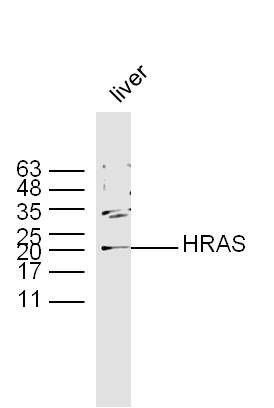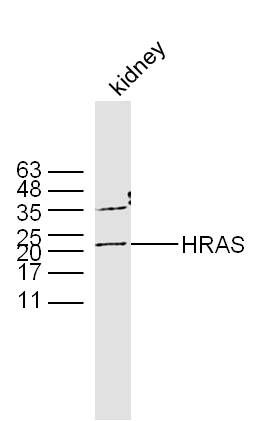上海细胞库
人源细胞系| 稳转细胞系| 基因敲除株| 基因点突变细胞株| 基因过表达细胞株| 重组细胞系| 猪的细胞系| 马细胞系| 兔的细胞系| 犬的细胞系| 山羊的细胞系| 鱼的细胞系| 猴的细胞系| 仓鼠的细胞系| 狗的细胞系| 牛的细胞| 大鼠细胞系| 小鼠细胞系| 其他细胞系|

| 规格 | 价格 | 库存 |
|---|---|---|
| 50ul | ¥ 980 | 200 |
| 100ul | ¥ 1680 | 200 |
| 200ul | ¥ 2480 | 200 |
| 中文名称 | 原癌基因H-ras抗体 |
| 别 名 | c bas/has; c H ras; c has/bas p21 protein; C K RAS; c K ras2 protein; c Ki ras; c Kirsten ras protein; c ras Ki 2 protein; Cellular c Ki ras2 proto oncogene antibody G1III6 N ras; GTPase HRas; GTPase KRas; GTPase NRas; H Ras 1; H RasIDX; Ha Ras; HRAS 1; HRAS; HRAS1; K Ras 2; K ras; K ras p21 protein; K RAS2A; K RAS2B; K RAS4A; K RAS4B; KI RAS; Kirsten rat sarcoma 2 viral (v Ki ras2) oncogene homolog; KRAS 1; KRAS 2; KRAS; KRAS1; KRAS2; N ras; N ras oncogene; Neuroblastoma RAS viral (v ras) oncogene homolog; NRAS 1; NRAS; NRAS1; NS3; Oncogene KRAS2; p21ras; PR310 c K ras oncogene antibody RASH 1; RASH1; RASK 2; RASK2; Transforming protein N Ras; Transforming protein p21; v Ha ras Harvey rat sarcoma viral oncogene homolog; v Ki ras2 Kirsten rat sarcoma 2 viral oncogene homolog; v Ki ras2 Kirsten rat sarcoma viral oncogene homolog; v ras neuroblastoma RAS viral oncogene homolog; RASH_HUMAN. |
| 研究领域 | 肿瘤 免疫学 信号转导 结合蛋白 |
| 抗体来源 | Rabbit |
| 克隆类型 | Polyclonal |
| 交叉反应 | Mouse, Rat, (predicted: Human, Chicken, Rabbit, ) |
| 产品应用 | WB=1:500-2000 ELISA=1:500-1000 IHC-P=1:100-500 IHC-F=1:100-500 IF=1:100-500 (石蜡切片需做抗原修复) not yet tested in other applications. optimal dilutions/concentrations should be determined by the end user. |
| 分 子 量 | 21kDa |
| 细胞定位 | 细胞核 细胞浆 细胞膜 |
| 性 状 | Liquid |
| 浓 度 | 1mg/ml |
| 免 疫 原 | KLH conjugated synthetic peptide derived from human H-ras:101-152/152 |
| 亚 型 | IgG |
| 纯化方法 | affinity purified by Protein A |
| 储 存 液 | 0.01M TBS(pH7.4) with 1% BSA, 0.03% Proclin300 and 50% Glycerol. |
| 保存条件 | Shipped at 4℃. Store at -20 °C for one year. Avoid repeated freeze/thaw cycles. |
| PubMed | PubMed |
| 产品介绍 | This gene belongs to the Ras oncogene family, whose members are related to the transforming genes of mammalian sarcoma retroviruses. The products encoded by these genes function in signal transduction pathways. These proteins can bind GTP and GDP, and they have intrinsic GTPase activity. This protein undergoes a continuous cycle of de- and re-palmitoylation, which regulates its rapid exchange between the plasma membrane and the Golgi apparatus. Mutations in this gene cause Costello syndrome, a disease characterized by increased growth at the prenatal stage, growth deficiency at the postnatal stage, predisposition to tumor formation, mental retardation, skin and musculoskeletal abnormalities, distinctive facial appearance and cardiovascular abnormalities. Defects in this gene are implicated in a variety of cancers, including bladder cancer, follicular thyroid cancer, and oral squamous cell carcinoma. Multiple transcript variants, which encode different isoforms, have been identified for this gene. [provided by RefSeq]. Function: Ras proteins bind GDP/GTP and possess intrinsic GTPase activity. Subunit: In its GTP-bound form interacts with PLCE1. Interacts with TBC1D10C. Interacts with RGL3. Interacts with HSPD1. Found in a complex with at least BRAF, HRAS1, MAP2K1, MAPK3 and RGS14. Interacts (active GTP-bound form) with RGS14 (via RBD 1 domain) (By similarity). Forms a signaling complex with RASGRP1 and DGKZ. Interacts with RASSF5. Interacts with PDE6D. Interacts with IKZF3. Interacts with GNB2L1. Subcellular Location: Cell membrane. Cell membrane; Lipid-anchor; Cytoplasmic side. Golgi apparatus. Golgi apparatus membrane; Lipid-anchor. Note=The active GTP-bound form is localized most strongly to membranes than the inactive GDP-bound form (By similarity). Shuttles between the plasma membrane and the Golgi apparatus. Isoform 2: Nucleus. Cytoplasm. Cytoplasm, perinuclear region. Note=Colocalizes with GNB2L1 to the perinuclear region. Tissue Specificity: Widely expressed. Post-translational modifications: Palmitoylated by the ZDHHC9-GOLGA7 complex. A continuouscycle of de- and re-palmitoylation regulates rapid exchange betweenplasma membrane and Golgi. S-nitrosylated; critical for redox regulation. Important forstimulating guanine nucleotide exchange. No structural perturbationon nitrosylation. The covalent modification of cysteine by15-deoxy-Delta12,14-prostaglandin-J2 is autocatalytic andreversible. It may occur as an alternative to other cysteinemodifications, such as S-nitrosylation and S-palmitoylation. Acetylation at Lys-104 prevents interaction with guaninenucleotide exchange factors (GEFs) (By similarity). DISEASE: Faciocutaneoskeletal syndrome (FCSS) [MIM:218040]: A rarecondition characterized by prenatally increased growth, postnatalgrowth deficiency, mental retardation, distinctive facialappearance, cardiovascular abnormalities (typically pulmonicstenosis, hypertrophic cardiomyopathy and/or atrial tachycardia),tumor predisposition, skin and musculoskeletal abnormalities.Note=The disease is caused by mutations affecting the generepresented in this entry. Congenital myopathy with excess of muscle spindles(CMEMS) [MIM:218040]: Variant of Costello syndrome. Note=Thedisease is caused by mutations affecting the gene represented inthis entry. Hurthle cell thyroid carcinoma (HCTC) [MIM:607464]: Arare type of thyroid cancer accounting for only about 3-10% of alldifferentiated thyroid cancers. These neoplasms are considered avariant of follicular carcinoma of the thyroid and are referred toas follicular carcinoma, oxyphilic type. Note=Diseasesusceptibility is associated with variations affecting the generepresented in this entry. Note=Mutations which change positions 12, 13 or 61activate the potential of HRAS to transform cultured cells and areimplicated in a variety of human tumors. Bladder cancer (BLC) [MIM:109800]: A malignancyoriginating in tissues of the urinary bladder. It often presentswith multiple tumors appearing at different times and at differentsites in the bladder. Most bladder cancers are transitional cellcarcinomas that begin in cells that normally make up the innerlining of the bladder. Other types of bladder cancer includesquamous cell carcinoma (cancer that begins in thin, flat cells)and adenocarcinoma (cancer that begins in cells that make andrelease mucus and other fluids). Bladder cancer is a complexdisorder with both genetic and environmental influences.Note=Disease susceptibility is associated with variations affectingthe gene represented in this entry. Note=Defects in HRAS are the cause of oral squamous cellcarcinoma (OSCC). Schimmelpenning-Feuerstein-Mims syndrome (SFM)[MIM:163200]: A disease characterized by sebaceous nevi, often onthe face, associated with variable ipsilateral abnormalities of thecentral nervous system, ocular anomalies, and skeletal defects.Many oral manifestations have been reported, not only includinghypoplastic and malformed teeth, and mucosal papillomatosis, butalso ankyloglossia, hemihyperplastic tongue, intraoral nevus, giantcell granuloma, ameloblastoma, bone cysts, follicular cysts,oligodontia, and odontodysplasia. Sebaceous nevi follow the linesof Blaschko and these can continue as linear intraoral lesions, asin mucosal papillomatosis. Note=The disease is caused by mutationsaffecting the gene represented in this entry. Similarity: Belongs to the small GTPase superfamily. Ras family. SWISS: P01112 Gene ID: 3265 Database links: Entrez Gene: 3265 Human Entrez Gene: 15461 Mouse Entrez Gene: 293621 Rat Omim: 190020 Human SwissProt: P01112 Human SwissProt: Q61411 Mouse SwissProt: P20171 Rat Unigene: 37003 Human Unigene: 334313 Mouse Unigene: 102180 Rat Important Note: This product as supplied is intended for research use only, not for use in human, therapeutic or diagnostic applications. GDP/GTP结合蛋白(GDP/GTP Bijding Protein) 细胞信号转导系统紊乱是肿瘤细胞生长的重要特征之一,Ras蛋白参与体内多种细胞信号转导途径而发挥作用,而原癌基因H-ras是一种多功能的细胞因子,广泛存在于自然界,H-ras在多种细胞生命活动中起极为重要的作用,包括细胞的增殖、分化和细胞骨架的构建等等,该抗体主要用于肿瘤方面的研究。 |
| 产品图片 |  Sample: Sample:Liver (Mouse) Lysate at 40 ug Primary: Anti-HRAS (bs-1071R) at 1/300 dilution Secondary: IRDye800CW Goat Anti-Rabbit IgG at 1/20000 dilution Predicted band size: 21 kD Observed band size: 21 kD  Sample: Sample:Kidney (Mouse) Lysate at 40 ug Primary: Anti-HRAS (bs-1071R) at 1/300 dilution Secondary: IRDye800CW Goat Anti-Rabbit IgG at 1/20000 dilution Predicted band size: 21 kD Observed band size: 21 kD Tissue/cell: rat brain tissue; 4% Paraformaldehyde-fixed and paraffin-embedded; Antigen retrieval: citrate buffer ( 0.01M, pH 6.0 ), Boiling bathing for 15min; Block endogenous peroxidase by 3% Hydrogen peroxide for 30min; Blocking buffer (normal goat serum,C-0005) at 37℃ for 20 min; Incubation: Anti-HRAS/Ras/Ras p21 Polyclonal Antibody, Unconjugated(bs-1071R) 1:200, overnight at 4°C, followed by conjugation to the secondary antibody(SP-0023) and DAB(C-0010) staining Tissue/cell: rat lung tissue; 4% Paraformaldehyde-fixed and paraffin-embedded; Antigen retrieval: citrate buffer ( 0.01M, pH 6.0 ), Boiling bathing for 15min; Block endogenous peroxidase by 3% Hydrogen peroxide for 30min; Blocking buffer (normal goat serum,C-0005) at 37℃ for 20 min; Incubation: Anti-HRAS/Ras/Ras p21 Polyclonal Antibody, Unconjugated(bs-1071R) 1:200, overnight at 4°C, followed by conjugation to the secondary antibody(SP-0023) and DAB(C-0010) staining |